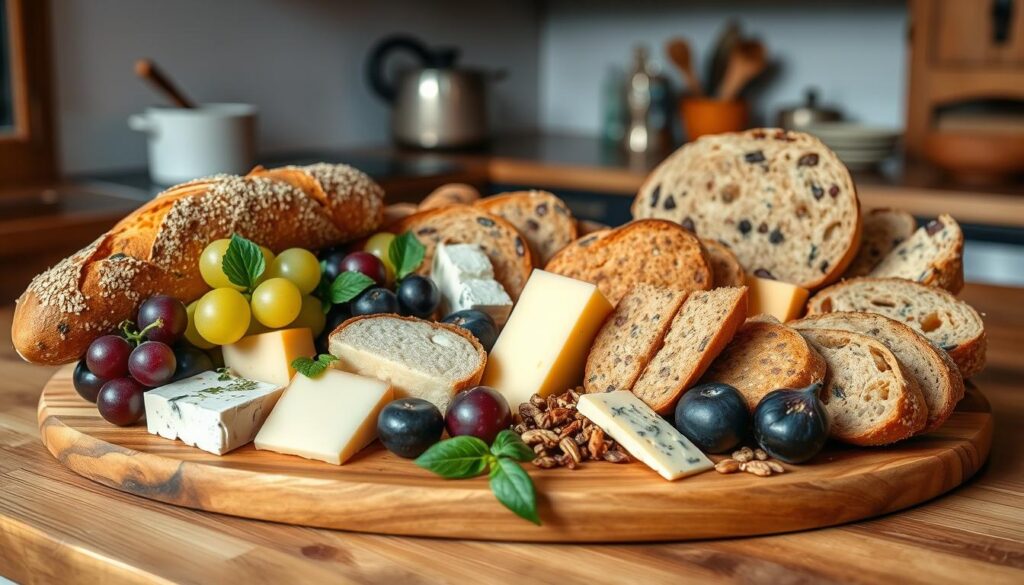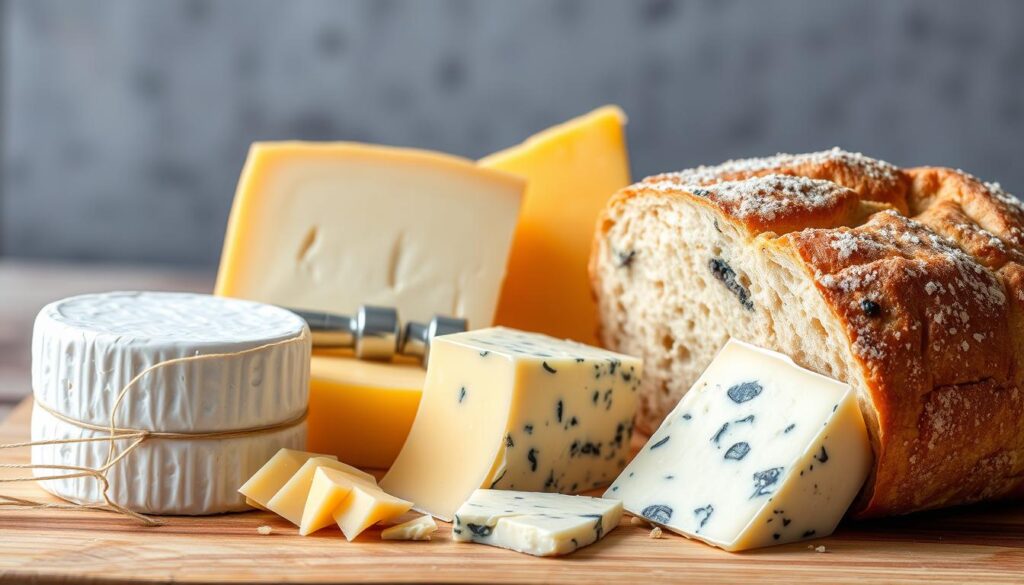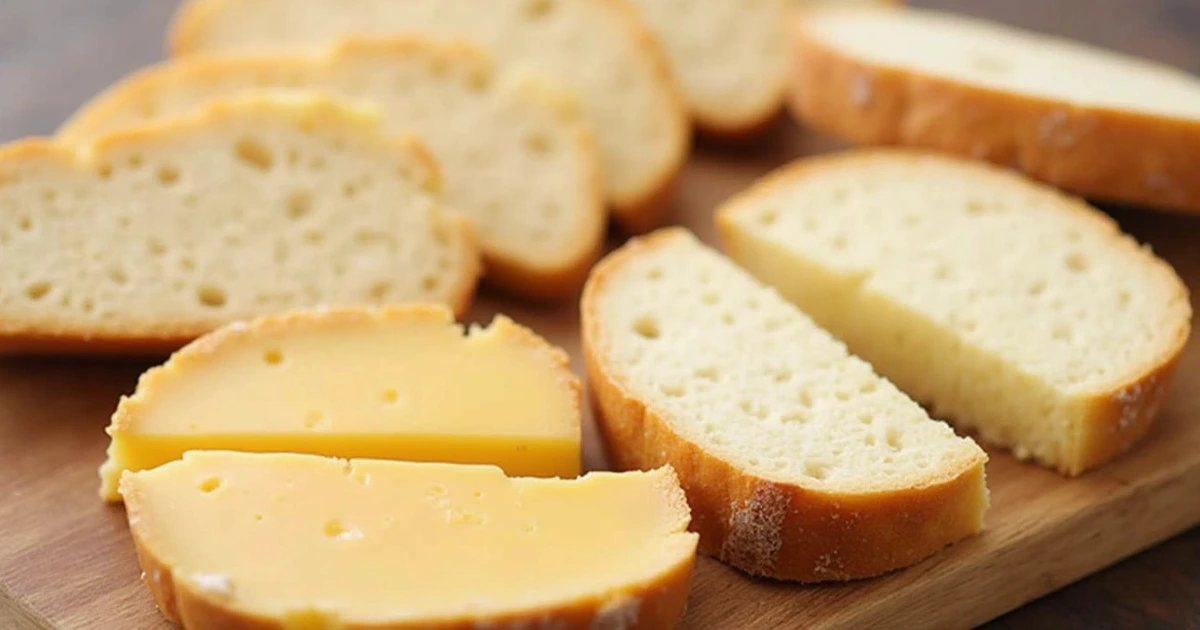Top 5 Bread and Cheese Pairings for Every Occasion 🧀🍞
Table of Contents
Table of Contents
Exploring bread and cheese pairings combinations can turn simple meals into amazing experiences. It starts with knowing how certain pairings can make ordinary ingredients taste incredible.
Bread and cheese are more than just food. They carry cultural traditions, regional skills, and complex flavors. These elements bring people together through food. When chosen carefully, they create perfect taste combinations that please everyone.
Each bread and cheese pairing has its own story. Imagine a rustic loaf with creamy aged cheddar or a soft sourdough with brie. The mix of texture, flavor, and origin makes each pairing unique. It’s a journey that will surprise and please your taste buds.
This guide will teach you the basics, regional traditions, and expert tips for choosing the best bread and cheese. Get ready to explore a world of flavors that will change how you see these classic foods.

Understanding the Art of Bread and Cheese Pairing
Exploring gourmet cuisine means learning about food pairings. These pairings turn simple ingredients into amazing dishes. Bread and cheese combinations are a special art that mixes science, tradition, and taste.
The Science Behind Perfect Pairings
Good food pairings come from how flavors mix. Your taste buds pick up on these mixtures, making food taste great. The right mix of bread and cheese can make a snack into a fancy treat.
- Flavor molecules interact across different ingredients
- Complementary taste profiles enhance the overall experience
- Molecular gastronomy principles guide perfect combinations
Basic Principles of Flavor Matching
Matching bread and cheese is all about flavor basics. Contrast and complement are key to great pairings. Strong cheeses go well with simple breads, and soft cheeses pair with hearty breads.
“Great pairings are about balance, not just matching flavors, but creating a symphony of taste.” – Culinary Expert
Temperature and Texture Considerations
Temperature and texture are key in gourmet food. Soft cheeses taste best at room temperature, and crusty breads add texture. When these are balanced, your taste buds go on a journey.
| Cheese Type | Ideal Serving Temperature | Bread Pairing Recommendation |
|---|---|---|
| Soft Brie | 60-70°F | Crusty French baguette |
| Aged Cheddar | 50-55°F | Sourdough bread |
Essential Types of Artisanal Bread for Pairing
Exploring the world of bakery products reveals a fascinating landscape of bread types. These can elevate your cheese experience. Breadmaking is an art form that transforms simple ingredients into complex flavors perfect for culinary pairings.
Different bread types offer unique characteristics that can complement or contrast cheese flavors. Let’s dive into some essential artisanal breads that will transform your cheese board:
- Baguette: A classic French bread with a crisp exterior and soft interior, ideal for soft and creamy cheeses
- Sourdough: Tangy and robust, perfect for pairing with aged and sharp cheeses
- Ciabatta: An Italian bread with large air pockets that works wonderfully with both mild and strong cheeses
- Rye Bread: Dense and slightly nutty, excellent with strong blue cheeses
“Bread is the canvas, cheese is the art” – Artisan Baker’s Wisdom
Understanding bread-making techniques can help you select the perfect bread for your cheese selection. The fermentation process, flour type, and baking method all contribute to the bread’s ultimate flavor profile.
| Bread Type | Texture | Best Cheese Pairing |
|---|---|---|
| Baguette | Crisp, Light | Brie, Camembert |
| Sourdough | Tangy, Dense | Aged Cheddar, Gruyère |
| Ciabatta | Airy, Soft | Mozzarella, Provolone |
| Rye Bread | Dense, Hearty | Gorgonzola, Roquefort |
Your bread selection can dramatically enhance the cheese-tasting experience. Experiment with different bakery products to discover your perfect combination!
The World of Cheese: From Soft to Hard Varieties
Exploring cheese varieties is a journey through dairy products. Cheese-making turns milk into tasty treats with unique textures and flavors. It’s a culinary adventure that starts with knowing the different types of cheese.
- Fresh and Soft Cheeses
- Semi-soft and Semi-Hard Cheeses
- Hard and Aged Cheeses
Fresh and Soft Cheeses
These cheeses are young, creamy, and often spreadable. They have mild flavors and smooth textures. Some popular ones are:
- Ricotta
- Mascarpone
- Fresh Mozzarella
- Cream Cheese
Semi-soft and Semi-Hard Cheeses
These cheeses fall in the middle in terms of texture and flavor. They age a bit longer than soft cheeses but are still easy to slice.
| Cheese Name | Texture | Flavor Profile |
|---|---|---|
| Havarti | Creamy, smooth | Mild, buttery |
| Gouda | Firm, supple | Sweet, nutty |
| Monterey Jack | Smooth, compact | Gentle, subtle |
Hard and Aged Cheeses
These cheeses have strong flavors due to long aging. They are firm and great for grating, cooking, and enjoying in small amounts.
“The aging process enhances a cheese’s flavor, making it more complex over time.
- Parmesan
- Pecorino Romano
- Aged Cheddar
- Manchego
Knowing about these cheese types will make your cooking better. It helps you pick the right cheese for any dish.
Classic French Bread and Cheese Combinations
France is the top spot for bread and cheese lovers. The country’s food traditions make artisanal foods into art. French bread and cheese pairings are all about balance and culture.
Here are some famous French bread and cheese combos to try:
- Baguette with Brie: A classic mix of crisp bread and creamy cheese
- Pain de Campagne with Camembert: A rustic bread pairs well with soft, rich cheese
- Croissant with Comté: Buttery pastry meets nutty, aged cheese
“In France, bread and cheese transcend food—they embody a way of life.
When tasting, pay attention to how bread and cheese work together. Artisanal foods need careful choice and appreciation. Try different pairs to find your favorites.
Experts say to serve these at room temperature for the best taste. Let your bread cheese adventure be a tribute to French food excellence.
Italian Bread Cheese Traditions and Pairings
Italy’s culinary world is filled with a variety of breads and cheeses. These reflect centuries of tradition in gourmet cuisine. Each region has its special flavors that excite the taste buds and show off Italy’s rich food heritage.
Regional Italian Specialties
Italy’s different areas have their own bread and cheese matches. These highlight local ingredients and cooking ways. Some standout pairs include:
- Tuscany’s Pecorino Toscano with Crusty Pane Toscano
- Sicily’s ricotta with dense semolina bread
- Lombardy’s Gorgonzola alongside walnut bread
Mediterranean Flavor Profiles
Mediterranean food focuses on fresh, bold ingredients. The mix of bread textures and cheese tastes is amazing.
| Region | Bread Type | Cheese Variety | Flavor Profile |
|---|---|---|---|
| Campania | Ciabatta | Mozzarella di Bufala | Creamy, delicate |
| Emilia-Romagna | Focaccia | Parmigiano-Reggiano | Sharp, nutty |
| Veneto | Grissini | Asiago | Mild, smooth |
Traditional Serving Methods
Italian serving ways are simple and honor the quality of ingredients. Bread and cheese are best served at room temperature. This lets their true flavors come through.
In Italy, bread and cheese represent more than just food; they are a celebration of heritage and tradition.” – Italian Culinary Expert
When you try these pairings, aim for a balance that shows off each item’s special qualities. The goal is to enjoy a meal that feels like a trip to the Italian countryside.
Sourdough Pairings for Every Cheese Type

Sourdough breadmaking is a unique culinary adventure. It turns cheese into amazing food pairings. The tangy flavor of sourdough is perfect for exploring different cheese combinations.
“Sourdough is not just bread, it’s a flavor adventure waiting to be discovered.” – Artisan Baker
Learning about sourdough and cheese pairing is all about flavors and textures. The cheese you choose can change how it tastes.
- Mild Cheeses: Pair with classic sourdough for a subtle, balanced taste
- Medium Cheeses: Complement with slightly aged sourdough varieties
- Strong Cheeses: Match with robust, well-fermented sourdough breads
When picking sourdough for cheese pairings, look at these key points:
- Fermentation level
- Bread texture
- Flavor intensity
Sourdough breadmaking is incredibly versatile. It can make any cheese-tasting experience better. From creamy brie to sharp cheddar, sourdough can elevate it all.
“Bread and cheese are culinary soulmates, and sourdough is their perfect introduction.” – Gourmet Chef
Try different sourdough styles to find your favorite cheese pairings. The world of taste is endless, limited only by your creativity.
Creating the Perfect Cheese Board with Complementary Breads
Making a great cheese board is like creating a work of art. It turns simple gatherings into unforgettable moments. Your board should be a journey through top-notch foods, with bread and cheeses that go well together.
Arrangement Techniques for Visual Appeal
To make your cheese board look amazing, follow these tips:
- Start by arranging your selection on a large wooden board or slate platter for an elegant presentation.
- Place cheeses at different heights using small risers or bowls
- Create color contrast with fresh herbs and edible flowers
- Group cheeses from mild to strong flavors
Seasonal Considerations for Cheese Selection
Your cheese board should match the season’s tastes. In summer, choose light, fresh cheeses. In winter, go for rich, aged ones.
| Season | Recommended Cheeses | Bread Pairings |
|---|---|---|
| Summer | Fresh mozzarella, goat cheese | Focaccia, olive bread |
| Winter | Aged cheddar, blue cheese | Rustic sourdough, rye bread |
Portion Guidelines for Perfect Serving
Here’s how to serve your cheese board right:
- Plan 2-3 ounces of cheese per person
- Offer 2-3 different cheese types
- Provide approximately 1-2 slices of bread per cheese variety
“A well-curated cheese board is like a delicious symphony of flavors, where each ingredient plays a perfect note.” – Culinary Expert
Rustic Bread and Farmhouse Cheese Combinations
Exploring rustic bakery products and dairy products shows a beautiful bond. This bond is between traditional foods and local cooking traditions. Farmhouse cheeses and hearty whole-grain breads together make a sensory delight. They celebrate local craftsmanship.
“Great bread and cheese are like a love story – each enhancing the other’s unique qualities.” – Artisan Food Maker
When picking rustic bread and farmhouse cheese, keep these tips in mind:
- Match strong bread textures with bold cheese flavors
- Look for local bakeries and dairy farms for real experiences
- Try different grains and milk
Some top pairings are:
- Sourdough with aged cheddar
- Whole wheat bread with tangy goat cheese
- Rye bread with nutty Alpine-style cheese
Artisanal foods from different regions are incredibly varied. A Vermont whole wheat bread might go great with a local raw milk cheese. On the other hand, a California walnut loaf could pair well with creamy sheep’s milk cheese.
Your adventure in rustic bread and farmhouse cheese will open a world of deep, real flavors. These flavors connect you to traditional cooking skills.
Wine and Beer Suggestions for Bread Cheese Tastings
Understanding the art of pairing bread, cheese, and drinks is key to a great gourmet experience. The right drink can turn a simple tasting into a memorable culinary adventure.

Choosing the perfect drink is all about matching flavors and intensities. You want to find combinations that make both the bread and cheese shine.
Red Wine Pairings
- Cabernet Sauvignon pairs beautifully with aged cheddar
- Pinot Noir complements soft brie and camembert
- Malbec works well with robust blue cheeses
White Wine Selections
- Chardonnay matches perfectly with creamy goat cheese
- Sauvignon Blanc elevates fresh, mild cheeses
- Riesling balances tangy, sharp cheese varieties
Craft Beer Options
| Beer Style | Cheese Pairing |
|---|---|
| IPA | Sharp cheddar |
| Wheat Beer | Soft fresh cheeses |
| Stout | Smoked gouda |
“The secret to perfect pairings lies in balancing flavors and textures.” – Cheese Sommelier
Try out these pairing ideas to find your favorite gourmet combinations. Remember, what you like is what matters most in food pairings.
Entertaining with Bread and Cheese: Presentation Tips
To impress your guests, you need more than just great ingredients. How you present your food can elevate the entire dining experience and make a lasting impression. A well-presented cheese board can be a memorable experience.
Your display should appeal to all senses. Start with a wooden board or slate platter. It adds a rustic touch to your selection.
- Choose varied board heights and textures
- Create visual interest with different cheese shapes
- Use small ramekins for accompaniments
- Include fresh herbs as decorative elements
Temperature is key when serving. Let cheeses warm up 30-45 minutes before serving. This brings out their flavors. Place soft cheeses away from hard ones to avoid mixing flavors.
“A thoughtfully arranged cheese board is like an edible masterpiece.” – Culinary Expert
Pair your cheeses with the right foods. Add:
- Fresh seasonal fruits
- Honey or fruit preserves
- Toasted nuts
- Dried fruit selections
Visual appeal is as important as taste. Arrange items nicely, use small cheese labels, and have the right utensils for each cheese.
Storage and Serving Temperature Guidelines
Keeping your bakery products and dairy products fresh is key. Whether you love making cheese or just enjoy eating it, knowing how to store and serve is important. It makes your food taste better.
Storing bread and cheese right is essential. Each type needs special care to stay fresh and tasty.
Optimal Storage Methods
- Wrap artisan breads in paper bags or cotton cloths to maintain crispness
- Store soft cheeses in airtight containers and keep them refrigerated to maintain their freshness.
- Keep hard cheeses wrapped in wax paper or specialized cheese paper
- Avoid plastic wrap for most cheese varieties to prevent moisture buildup
Temperature Recommendations
The right serving temperature can change how your cheese and bread taste. Each type needs a different approach to taste its best.
| Cheese Type | Ideal Serving Temperature | Storage Temperature |
|---|---|---|
| Soft Cheeses | 50-55°F | 40°F |
| Hard Cheeses | 55-60°F | 35-40°F |
| Artisan Bread | Room Temperature | Cool, dry place |
Freshness Duration
Knowing how long your food stays fresh helps you plan. It also helps you avoid wasting food.
- Fresh bread: 2-3 days at room temperature
- Soft cheeses: 1-2 weeks refrigerated
- Hard cheeses: 3-4 weeks when properly stored
“The secret to great food is not just in the preparation, but in its storage and serving.” – Culinary Expert
By following these tips, your cheese and bread will stay delicious. This way, you can enjoy their unique flavors and textures.
Conclusion
Exploring bread and cheese pairings is a fun journey of taste and discovery. You’ve learned how different textures and flavors can make simple ingredients special. From the science of perfect pairings to classic and new ones, you’re ready to create unforgettable moments.
The art of choosing bread and cheese is all about personal discovery. Each pairing shares a story of flavor, texture, and culture. Whether for guests or a quiet moment, your skills will make every taste experience better. Remember, confidence comes from knowing the basics and being open to trying new things.
Your culinary journey is just starting. Find new bread and cheese combinations, visit local markets, and explore specialty shops. Each place and culture has its flavors waiting to be found. Trust your taste, be creative, and enjoy exploring bread and cheese.
FAQ
What are the best bread and cheese combinations for beginners?
Start with classics like a crusty baguette with Brie, sourdough with aged cheddar, or ciabatta with mozzarella. These pairings offer a mix of textures and tastes that are easy to enjoy.
How do I store different types of bread and cheese?
Keep hard cheeses in wax paper in the fridge, and soft cheeses in their original packaging—store bread in a cool, dry place. Use a bread box or paper bag for artisanal bread to keep it fresh. Avoid plastic bags to prevent bread from getting soggy.
What temperature should cheese be served at?
Most cheeses are best at room temperature, around 60-70°F. Remove cheese from the fridge 30-60 minutes before serving to allow it to reach its optimal flavor and texture. This lets the flavors and aromas fully develop. Soft cheeses need less time, while harder cheeses benefit from longer warming.
Can I pair wine or beer with my bread and cheese?
Yes! Pair a crisp white wine with goat cheese, a bold red with aged cheddar, or a craft beer with sourdough. Match the beverage’s intensity with the cheese and bread’s flavors.
How do I create an impressive cheese board?
Choose 3-5 cheeses with different textures and tastes. Add breads, crackers, and items like honey, nuts, and dried fruits. Use various-sized boards and arrange items nicely, leaving space between them.
What are the main categories of cheese?
Cheese falls into four main groups: fresh and soft, semi-soft, semi-hard, and hard and aged. Each group has unique textures, flavors, and aging processes.
How can I determine if the bread is fresh?
Fresh bread has a crisp crust, soft inside, and a yeasty smell. Avoid bread that’s hard, dry, moldy, or stale. Artisanal and freshly baked breads taste and feel the best.
Are there vegetarian-friendly cheese options?
Yes, many cheeses are vegetarian. Look for cheeses made with vegetable or microbial rennet instead of animal rennet. Mozzarella, feta, ricotta, and many soft cheeses are good options.
Did You Try Our Recipe?
There are no reviews yet. Be the first one to write one.

